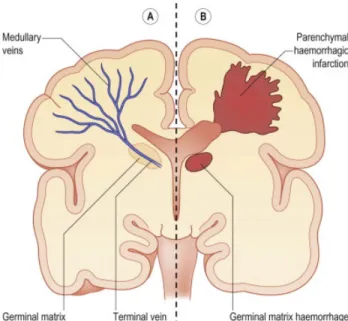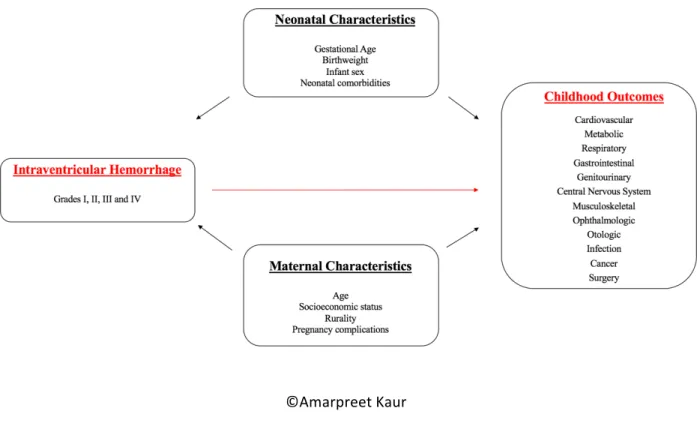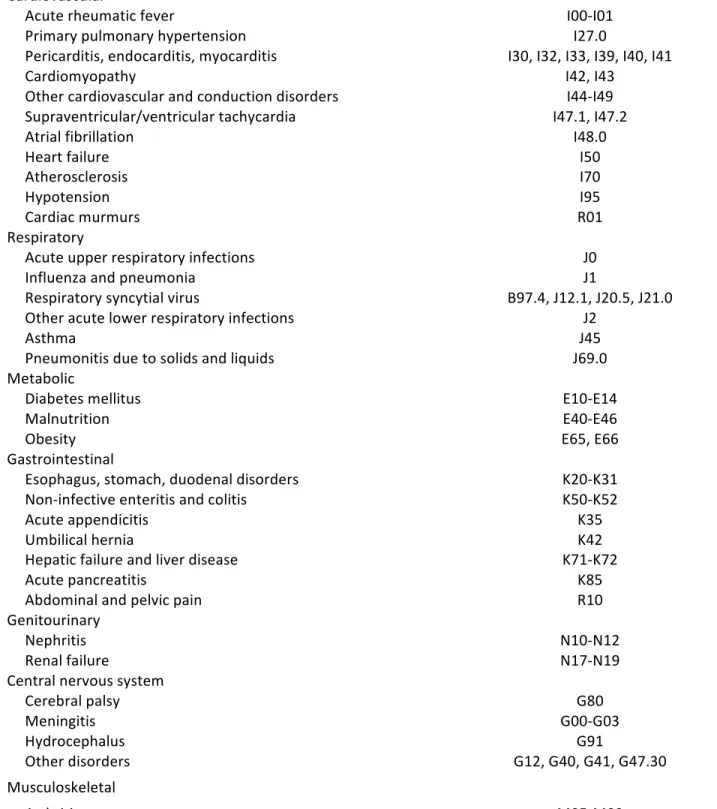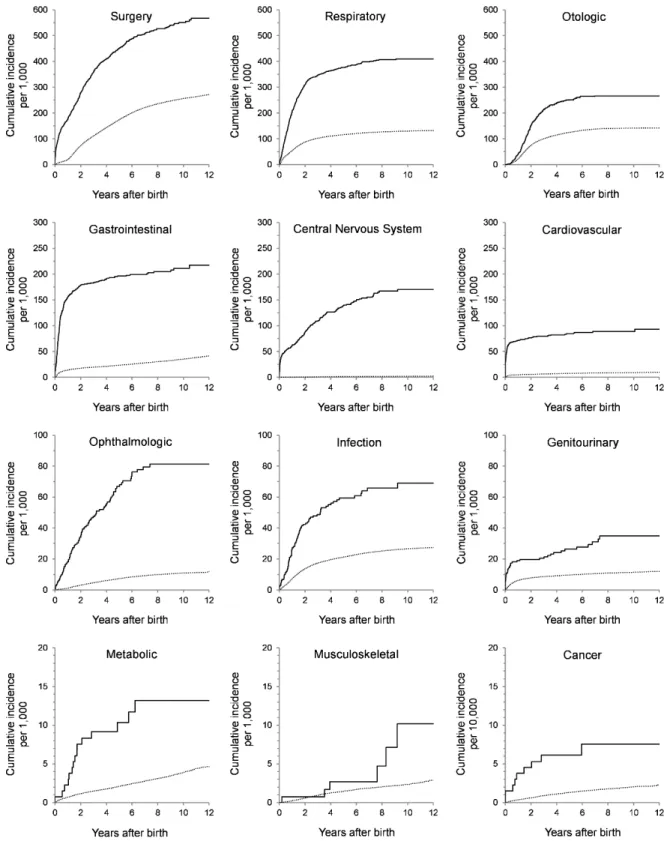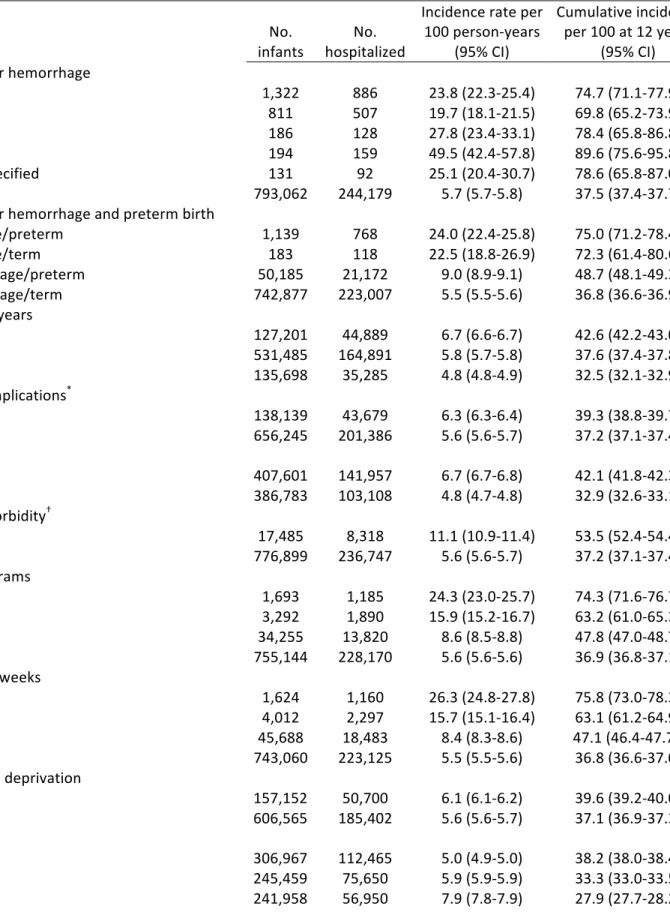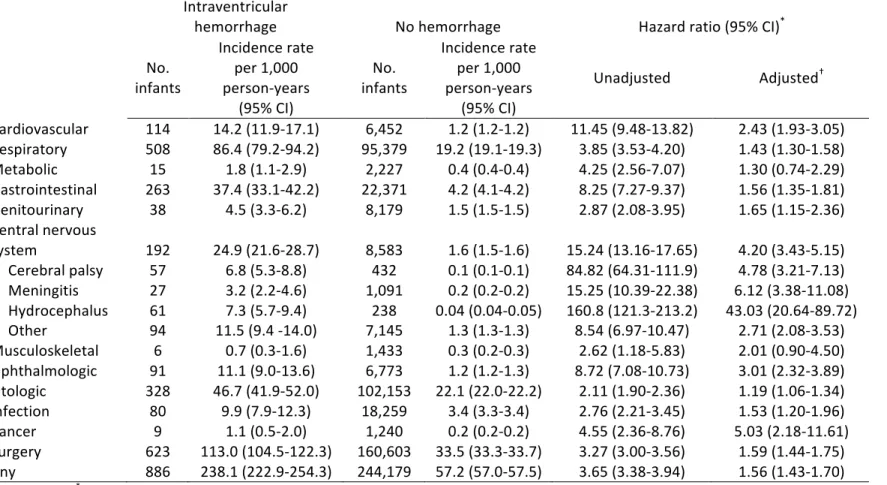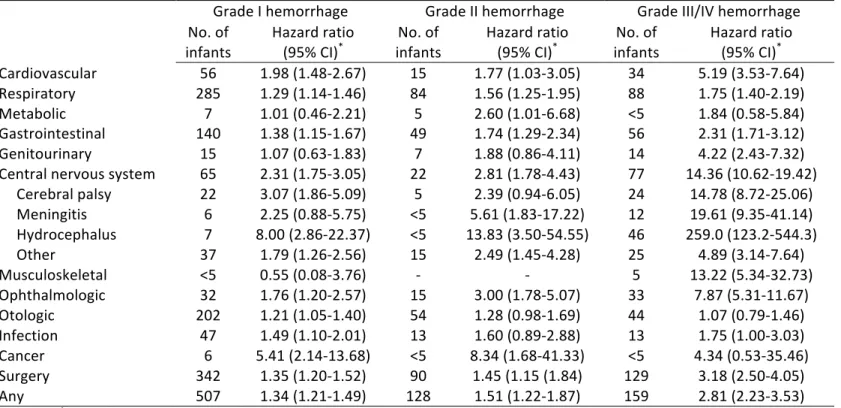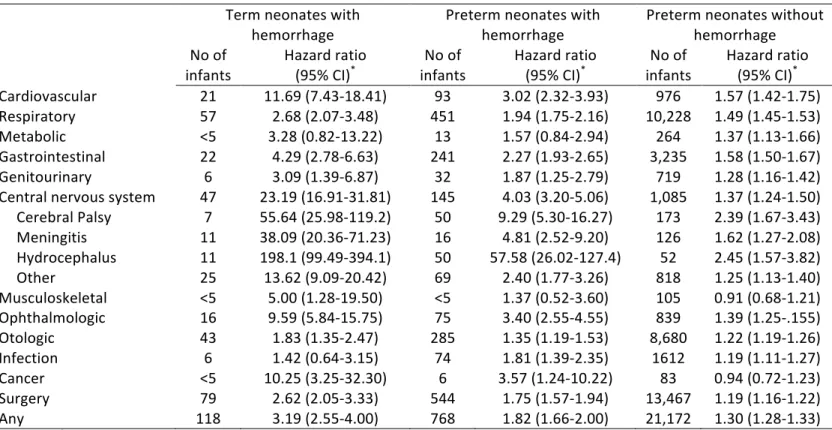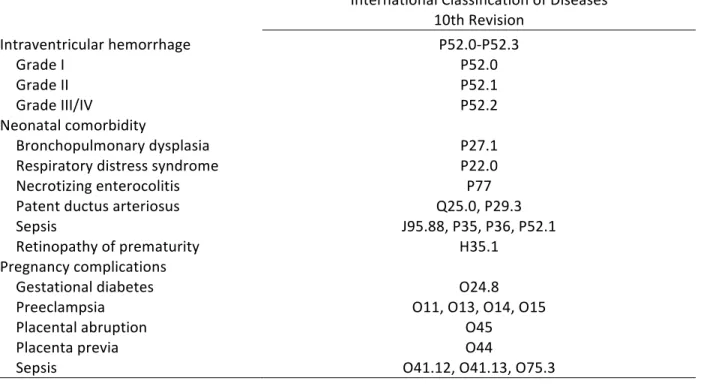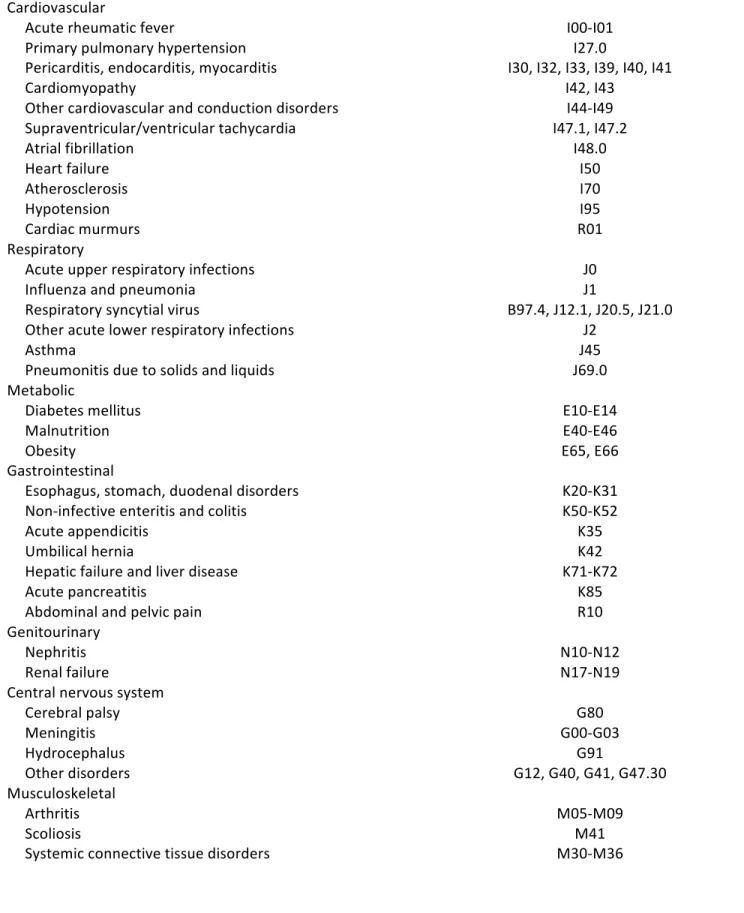Université de Montréal Neonatal intraventricular hemorrhage and hospitalization in childhood Par Amarpreet Kaur Département de médecine sociale et préventive École de santé publique Mémoire présenté en vue de l’obtention du grade de Maîtrise ès sciences en Épidémiologie Août 2019 © Amarpreet Kaur, 2019
Université de Montréal Unité académique : Département de médicine sociale et présentative, École de santé publique Ce mémoire intitulé Neonatal intraventricular hemorrhage and hospitalization in childhood Présenté par Amarpreet Kaur A été évalué par un jury composé des personnes suivantes Dre Lise Gauvin Président-rapporteur Dre Nathalie Auger Directeur de recherche Dre Marie-Claude Rousseau Membre du jury
Résumé
Contexte: L’hémorragie intraventriculaire néonatale est associée à des séquelles neuro-développementales, mais le risque à long terme d'autres issues est inconnu. L'association entre l'hémorragie intraventriculaire néonatale et le risque de morbidité durant l’enfance a été évaluée. Méthodes: Une cohorte longitudinale de 794,384 bébés nés entre 2006 et 2016 au Québec, Canada a été analysé. Les nouveau-nés ont été suivis jusqu'à une période de 12 ans après leur naissance, pour identifier les hospitalisations subséquentes. Dans les modèles de régression de Cox, ajustés pour les caractéristiques maternelles et néonatales, les « hazard ratios » et intervalles de confiance (IC) à 95% ont été estimés pour l'association entre l'hémorragie intraventriculaire avec l’hospitalisation ultérieure. Résultats: Au total, 1,322 nourrissons (0,2%) ont développé une hémorragie intraventriculaire de grade I à IV. L'incidence de l'hospitalisation était plus élevée chez les bébés présentant une hémorragie intraventriculaire que chez les bébés sans hémorragie (23,8 vs 5,7 par 100 personnes-années). Comparés aux bébés sans hémorragie, les bébés affectés avaient un risque d'hospitalisation 1,56 fois plus élevé (IC à 95% 1,43-1,70). Le risque était 2,81 fois plus élevé pour les grades III/IV (IC à 95% 2,23 à 3,53) comparés à ceux nés sans hémorragie. Les hémorragies intraventriculaires pré-terme était associée à 1,82 fois le risque (IC 95% 1,66-2,00) comparés aux bébés nés termes sans hémorragie. Les hémorragies intraventriculaires à terme étaient associées à 3,19 fois le risque d'hospitalisation (IC 95% 2,55-4,00), comparativement à ceux nés termes sans hémorragie. Les raisons principales des hospitalisations comprenaient les maladies du système nerveux central, ophtalmologiques, musculo-squelettiques et cardiovasculaires. Conclusion: L'hémorragie intraventriculaire, notamment de grades sévères et parmi les bébés à terme, est un déterminant important du futur risque d’hospitalisation durant l’enfance. Mots-clés: Hémorragie cérébrale; Hospitalisation; Effet à long terme; Morbidité; Bébé prématuré
Abstract
Background: Neonatal intraventricular hemorrhage is associated with neurodevelopmental sequelae, but the long-term risk of other outcomes is unknown. The association between neonatal intraventricular hemorrhage and the risk of childhood morbidity was assessed. Methods: A longitudinal cohort of 794,384 infants born between 2006 and 2016 in Quebec, Canada was analyzed. Infants were tracked over time to identify later hospitalizations with follow-up extending up to 12 years after birth. In Cox regression models adjusted for maternal and infant characteristics, the hazard ratios and 95% confidence intervals (CI) were estimated for the association of intraventricular hemorrhage with future hospitalization. Results: A total of 1,322 (0.2%) infants developed grade I to IV intraventricular hemorrhage. The incidence of childhood hospitalization was higher in infants with intraventricular hemorrhage than in infants without hemorrhage (23.8 vs. 5.7 per 100 person-years). Compared with no hemorrhage, infants with intraventricular hemorrhage had 1.56 times the risk of hospitalization (95% CI 1.43-1.70). The risk was 2.81 times higher for grade III/IV hemorrhage (95% CI 2.23-3.53) compared to those born without hemorrhage. Preterm intraventricular hemorrhage was associated with 1.82 times the risk (95% CI 1.66-2.00) compared to term infants born without hemorrhage. Intraventricular hemorrhage at term was associated with 3.19 times the risk of hospitalization (95% CI 2.55-4.00) compared to those born term without hemorrhaging. Primary reasons for hospitalizations included central nervous system, ophthalmologic, musculoskeletal, and cardiovascular disorders. Conclusion: Intraventricular hemorrhage, especially of higher grades and in term neonates, is an important determinant of the future risk of child hospitalization. Keywords: Brain hemorrhage; Hospitalization; Long-term effect; Morbidity; Preterm infant
Table of contents
Résumé ... 5
Abstract ... 7
Table of contents ... 9
List of tables ... 13
List of figures ... 15
List of abbreviations ... 17
Acknowledgments ... 21
Chapter 1 ... 23
1. Introduction ... 23
Chapter 2 ... 25
2. Literature review ... 25
2.1 Definition and descriptive epidemiology ... 25
2.1.1 Pathophysiology and risk factors of intraventricular hemorrhage ... 25
2.1.2 Severity of intraventricular hemorrhage ... 27
2.1.3 Timing of intraventricular hemorrhage ... 28
2.1.4 Public health implications ... 30
2.2 Neonatal characteristics ... 31
2.2.1 Gestational age ... 31
2.2.2 Birthweight ... 31
2.2.3 Infant sex ... 31
2.2.4 Neonatal comorbidities ... 32
2.3 Maternal characteristics ... 34
2.3.1 Age ... 34
2.3.2 Socioeconomic status ... 34
2.3.3 Rurality ... 34
2.3.4 Pregnancy complications ... 35
2.4 Current knowledge of intraventricular hemorrhage outcomes ... 36
2.4.1 Long-term neurodevelopmental outcomes ... 36
2.4.2 Long-term morbidity ... 38
2.4.3 Mortality ... 39
2.5 Summary of literature review ... 40
2.6 Research objectives ... 41
Chapter 3 ... 43
3. Conceptual framework ... 43
Chapter 4 ... 45
4. Methods ... 45
4.1 Context and study design: Analysis of secondary data ... 45
4.2 Population and exclusion criteria ... 45
4.3 Definition of exposure ... 46
4.4 Definition of outcomes ... 48
4.5 Definition of covariates ... 51
4.6 Data analysis ... 53
4.6.1 Descriptive analysis ... 53
4.6.2 The Cox regression model and analysis ... 54
4.6.3 Sensitivity analysis and statistical software ... 55
4.7 Ethics ... 57
Chapter 5 ... 59
5. Results ... 59
5.1 Article ... 59
Chapter 6 ... 83
6. Discussion ... 83
6.1 Key findings ... 83
6.2 Strengths and limitations ... 87
6.3 Clinical and public health implications ... 89
6.4 Directions for future research ... 89
Bibliographic References ... 91
List of tables
Table 1. – Definition of exposure ... 47 Table 2. – Definition of hospitalization outcomes ... 49 Table 3. – Definition of neonatal covariates ... 51 Table 4. – Definition of maternal covariates ... 52 Table 5. – Incidence of childhood hospitalization according to maternal and infant ... 74Table 6. – Intraventricular hemorrhage and incidence of hospitalization for specific childhood disorders ... 76 Table 7. – Severity of intraventricular hemorrhage and risk of later disorders in childhood ... 77 Table 8. – Intraventricular hemorrhage and risk of childhood hospitalization in term and preterm infants ... 78 Table 9. – International Classification of Diseases codes for intraventricular hemorrhage and maternal-infant comorbidity ... 79 Table 10. – International Classification of Diseases codes for childhood hospitalization outcomes ... 80
List of figures
Figure 1. – Cross section of brain and outlying germinal matrix ... 28 Figure 2. – Conceptual framework for the association of intraventricular hemorrhage and childhood outcomes ... 44 Figure 3. – Intraventricular hemorrhage and cumulative incidence of childhood hospitalization ... 73List of abbreviations
ART: Assisted reproductive technology BPD: Bronchopulmonary dysplasia CIC: Cumulative incidence curve CIF: Cumulative incidence function CSF: Cerebral spinal fluid ELBW: Extremely low birthweight HR: Hazard ratio ICD: The international Classification of Disease ICF: The International Classification of Functioning Disability and Health IVH: Intraventricular hemorrhage INSPQ: Institute National de Santé Publique du Québec Med-Echo: Maintenance and Use of Data for the Study of Hospital Clientele Registry NEC: Necrotizing enterocolitis PDA: Patent ductus arteriosus RAMQ: Régie d’Assurance Maladie du Québec RDS: Respiratory distress syndrome ROP: Retinopathy of prematurity SAS: Statistical Analysis Software SRY: Sex determining region Y VLBW: Very low birthweight WHO: World Health Organization 95% CI: 95% confidence intervalThis thesis is dedicated to the population of infants in the neonatal intensive care unit, their families & the team of healthcare providers that have participated in the clinical management of children with intraventricular hemorrhage.
Acknowledgments
Dr. Nathalie Auger I would like to express my sincerest gratitude for your time and contribution towards the progression of my manuscript and thesis. Your medical expertise and clinical insight is invaluable and I have learned a great deal through your exemplary actions. Dr. Auger, you are exceptionally caring and always took the time to support my research interests. Thank you for providing precious coaching and encouragement as it has allowed me to learn and grow. I shall forever remember your words, my mentor. Aimina Ayoub, I would like to convey my appreciation for your mentorship and time. Thank you for the support dedicated towards teaching me statistical software and honing my epidemiology skills. For continuously being available to review my work & prompt me to become a better learner. I shall cherish your recognition and kindness. My warm wishes to the whole team of the INSPQ for being extremely welcoming and allowing me to have a positive experience. To my family, thank you for your unconditional support throughout the duration of my studies. Thank you for recognizing my research interests and encouraging me to pursue graduate studies on a topic that I cherish deeply. Your love and support has enabled me to write this thesis. Mandeep, you have been my backbone and my best friend throughout every aspect of my life. You have tremendously supported my career ambitions and allowed me to pursue them. Since the very start I have always felt the encouragement from you and it has kept my motivation strong. Embarking on this graduate journey was not easy and I thank you for all your support. Thank you for serving our country, I salute you. Lastly, I would like to acknowledge the Jewish General Hospital for having positively changed my life. For providing an environment that shaped my interests, changed my perception on life and enabled me to save lives.
Chapter 1
1. Introduction
Infants with intraventricular hemorrhage (IVH) have an elevated risk of neurodevelopmental disorders, but the association with other childhood morbidities is very poorly understood (1). IVH represents a serious neonatal neurological complication affecting primarily preterm infants (2). This condition is one of the most challenging to clinically manage and frequently implicates end of life decision-making (3). IVH occurs in 20-30% of preterm infants with very low birthweight (1). The pathophysiology is complex and multifactorial (4). The pathogenesis is mainly attributed to hemodynamic instability and vascular weakness of the germinal matrix in the developing brain (2,5). Infants are at increased risk of resuscitation, mechanical ventilation, surgery, and other complications during the neonatal period (6). Literature on childhood outcomes of IVH focus primarily on neurodevelopmental complications. Affected infants have substantial long-term neurocognitive morbidity (7). These children are at increased risk of cerebral palsy and neurosensory impairments including seizures, language delays, and behavioral disorders (1,8–10). Special educational support may be required at school (11). Almost 85% of infants with severe IVH have major neurocognitive deficiencies with an augmented risk of functional disability and gross motor impairments (8,12). Emerging research is showing that very low birthweight infants with neonatal comorbidities, including IVH, may have higher rates of orthopedic and ophthalmological hospitalizations, but information remains otherwise scarce (13). We sought to capture the extent of the association between IVH and future hospitalization before 12 years of age in a cohort of preterm and term newborns.
Chapter 2
2. Literature review
2.1 Definition and descriptive epidemiology
2.1.1 Pathophysiology and risk factors of intraventricular hemorrhage
During the neonatal period, infants are susceptible to an array of complications due to their physiological vulnerability. IVH is one such complication affecting upwards of 30% of high risk infants. IVH is described as blood loss from within the ventricular system of the brain. This kind of hemorrhaging is a subtype of intracranial injury (12). In the neonatal intensive care unit, germinal matrix associated IVH is a severe neurological complication. This condition is likely secondary to prematurity and represents the greatest type of central nervous system (CNS) disorder of a preterm birth.
The germinal matrix is a structure that arises during the embryonic period and persists until maturation of cerebral tissue after the infant is born. Significant growth of neuronal and glial precursor cells occurs in this region (5). The germinal matrix represents a site of rapid cellular proliferation with high vascularization and ongoing angiogenesis (14,15). Angiogenesis refers to the sprouting of existing vessels whereas vascularization entails creation of new blood vessels, and both constitute important steps in brain development. Vessels are important channels that supply blood to vital organs throughout the body. There are three types of vessels located in the brain: arteries, veins and capillaries (16). Veins have thinner endothelial walls as compared to arteries and IVH is largely associated to venous-vessel rupturing (5). In the developing and immature cerebrum, vessels can readily rupture due to their anatomical irregularities and large luminal areas (15).
Sophistication in neonatal medical management through use of antenatal steroids, improved ventilator support and postnatal surfactant has positively affected the survival of extremely premature infants (17). Great medical advancements have significantly reduced the age of viability to as low as 22-24 weeks of gestation (18,19). These changes have allowed high risk infants a chance at survival who otherwise would have died. In Canada, between 7-8% of all births are preterm and this number has remained mainly constant over a 10-year span.
High risk deliveries can contribute to an array of factors that may lead to the development of IVH. Low gestational age, birthweight and APGAR scores remain concerning risk factors for the development of IVH. The APGAR score evaluates appearance, pulse, grimace activity and respiration status immediately post birth. It represents an important standardized measure of infant health immediately after birth (15). Sustained low APGAR score at 1 and 5 mins of life is a risk factor for IVH development in the neonate (20). Prematurity can affect the functioning of various organ systems especially the lungs. Human lung organogenesis starts in the first trimester of pregnancy. Alveolar maturation reaches completion closer to the 35th week of gestation (21,22). Therefore, respiratory insufficiency is predominantly seen in babies born preterm but complications can also arise in term infants (23). Conditions such as respiratory distress syndrome and apnea are exhibited as direct results of prematurity (12). In the case of extremely preterm infants, they may require advance life-sustaining measures such as resuscitation, endotracheal intubation and mechanical ventilation due to reduced lung capacity (14,24). Moreover, these infants often require increased oxygenation in the first 24-hours of life through invasive or non-invasive support to maintain adequate tissue perfusion (12,15). Frequently, endotracheal intubation is maintained through conventional or high-frequency parameters in extremely premature babies (25). In the developing brain, inadequate pulmonary function can result in hypoxia-related tissue injury (16,24). Furthermore, hypoxic injury and fluctuation in systemic blood flow can develop into acid-base imbalances in the body (15,26). Thus, respiratory function plays a dynamic role in the development of IVH. These infants often have substantial physiological instability that require ongoing medical interventions.
Hemodynamic variability and coagulation disorders can contribute to the development of IVH. Hemodynamic variability represents altered perfusion levels in the body related to the cardiopulmonary system. Premature infants frequently exhibit anemia through low red blood cell counts, and thrombocytopenia through low platelet counts related to coagulation irregularities (24,27).When the production of red blood cells is insufficient, it has a direct impact on the tissue oxygenation. Red blood cells carry an important protein called hemoglobin which contains iron and its function is to transport oxygen molecules. It is not uncommon for infants to receive transfusion products to correct their anemic imbalances (28). As a result, hypervolemia (high blood volume) caused by transfusion products can affect systemic blood flow and induce further hemodynamic variability (24,29). Contrarily, hypotension arising from hypovolemia (low blood volume) or cardiac dysfunctions often require use of inotropic medication and volume expanders, which further contribute to systemic blood flow imbalances. Therefore, abrupt
upsurge or drop of systemic blood pressure can affect vessel integrity and cause vessel rupture which contributes to the development of IVH (15,30).
2.1.2 Severity of intraventricular hemorrhage
Cerebral ultrasounds and magnetic resonance imaging enables detection and diagnosis of IVH. Testing begins shortly after birth and if IVH is suspected, screening is routinely repeated to monitor progression of disease (31). Head circumference enables a crude measurement of hemorrhagic growth (32). Diagnosis of IVH entails carefully staging the severity of the bleed via the Papile classification which remains the standard medical diagnostic tool (4). In 1978, Dr. Papile described localized bleeding to the region of the germinal matrix as grade I. The germinal matrix is an area located near the head of the caudate nucleus in the subependymal zone (12). As illustrated in figure 1, the germinal matrix is located centrally in the brain, and in close proximity to the ventricles (33). If hemorrhaging persists, blood can extend into the ventricular system of the brain denoted as grade II. Classification at grade II represents less than 50% of sanguineous ventricular filling. In the context of bleeding progressing beyond the second stage, increased pressure from the excess blood causes ventricular dilation and is classified as grade III. At this point, diagnosis becomes moderate to severe and implies more than 50% of the ventricles are occupied with blood. Hemorrhaging surpassing grade III and extending into the surrounding parenchyma, results in grade IV classification. This last stage is considered the most severe form and results in post-hemorrhagic hydrocephalus or parenchymal infarction (12). Hydrocephalus refers to the accumulation of fluid in the brain due to blockage or obstruction. Parenchymal infarction is caused by severe hypoxic injury and can potentially lead to tissue damage or necrosis (tissue death). The parenchyma is the area outside the ventricles and contains an array of neurons and glial cells. Functional tissue is located in the parenchyma and damage to this area can lead to permanent cognitive impairment (12,15).Figure 1. – Cross section of brain and outlying germinal matrix (33)
Cerebral spinal fluid (CSF) is important for proper cerebral functioning as it protects the brain, removes waste and provides nutrients. CSF is produced in the ventricles and found within the subarachnoid spaces. The human brain is comprised of four ventricles. Two small lateral ventricles, plus a third and fourth ventricle which allows for the movement and reabsorption of cerebral spinal fluid through channels. In the brain, channels are anatomically known as foramen which are described as “openings” (16). The foramen of Monroe connects the third and fourth ventricle. There exists an anatomical proximity between the germinal matrix and the foramen of Monroe. Closeness of these two structures allows for facilitated introduction of significant blood volume into the ventricular system of the brain. Pathogenesis via this anatomical pathway is viewed in nearly 80% of cases (2,12).2.1.3 Timing of intraventricular hemorrhage
The pathology of IVH can vary as a function of gestational age. Preterm and term infants have distinct risk factors and mechanism of disease. Although, IVH is knowingly more prevalent in preterm infants, cases in term infants do exist. To begin, it is necessary to understand the pathology of IVH in preterm infants. The microvasculature of the subependymal germinal matrix is fragile. During the gestational period, the natural maturation and involution of the germinal matrix starts to occur near the34-36th week of postconceptional age. This embryonic structure then ceases to appear (24). Angiogenesis and cellular maturation slows down following this vulnerable period of fragility (15). Therefore, preterm infants are more likely to experience germinal matrix associated IVH. Injury to the germinal matrix may impact cellular maturation and migration to cortical regions of the brain (8,12). A subcategory of neuronal cells called pericytes are important players in maintaining the structural integrity of the endothelial tissue surrounding the microvasculature. The presence of intact endothelium helps prevent weakness and bleeding. Without pericytes, there is a reduction in the integrity of cerebral tissue leading to ruptures and breakdowns. It is observed that in preterm infants, there is a reduced density of pericytes in the germinal matrix. A reduction in pericytic action may increase tendency of vessel rupture (5).
In the term infant, IVH is a rare complication, often secondary to traumatic delivery or birth asphyxia (15). Trauma can arise from blunt mechanical force, whereas asphyxia entails severe lack of oxygen to vital parts of the brain. Developmental anomalies or structural faults may also contribute to the risk of IVH in term infants (34). At term, bleeding originates primarily from the choroid plexus as opposed to the subependymal zone. The anatomical location of the choired plexus lies within the ventricles and it also participates in the production of CSF. The germinal matrix does not exist in term infants as it has undergone involution. Vessels tend to have better structural integrity with substantial cellular maturation having already occurred in term infants as compared to preterm (5,12,15). In 1982, Scher et al described an interesting distinction between preterm and term infants with IVH (34). The clinical classification and prognosis of studied cases revealed important structural and anatomical differences. They demonstrated through post-mortem cross-sectional analysis of cerebral tissue that there existed a gestational age induced anatomical difference. Therefore, prediction of clinical outcomes of term infants with the equivalent diagnostic classification as preterm infants should not be alike. In term infants, tissue spasticity in the brain did not vary significantly as the grades of severity increased, unlike preterm infants. Therefore, it was implied that future developmental outcomes of term infants may differ from those of preterm infants. Birth timing is important to understand as etiologic risk factors differ amongst preterm and term infants. At term, hemorrhage inducing elements are related to mechanical and traumatic factors. Contrarily, for preterm it is due to anatomical immaturity and hemodynamic variability (12,34). Term infants may, therefore, have dissimilar developmental outcomes and follow altered pathways compared to preterm (34).
2.1.4 Public health implications
Clinical management of infants with IVH can be extensive. Neonatal intensive care and prolonged hospitalizations may be necessary. Depending on the severity of the cases, length of inpatient hospitalization can extend from weeks to months. Conjoined decision-making, in part from the parents and medical staff, is necessary to achieve what is in the best interest for the infant (19). Several interventions and treatments for extremely sick infants aim to maximize future quality of life. Public health wise, healthcare professionals caring for high risk patients can undergo significant emotional and physical repercussions. Emotional and physical taxation on the wellbeing of hospital personnel is common. Ethical and moral distress are two inevitable feelings that develop whilst caring for children with IVH. Viability and futility of care are important topics that arise and can have negative psychosocial effects on everyone involved (19). Anticipation of high-risk pregnancies and subsequent inpatient hospitalization of sick infants can be better managed through prenatal awareness and teaching. Various determinants of health characterized as maternal risk factors are associated to IVH. Determinants of health are factors that influence the overall health of an individual. Education, lifestyle choices, biology, social factors and income constitute some of the main determinants of health. Variable behaviours, such as smoking, constitute negative lifestyles choices which impose risks to our health and that of others. Each determinant of health can influence each other and affect the overall health of a person and of the people surrounding them. Universal Medicare is offered to Canadians and it helps subsidize the hefty costs of high risk cases and prolonged hospitalizations. Increased medical management leads to elevation in hospital-related costs, and infrastructure. In Canada, data from the Régie d’Assurance Maladie du Quebec (RAMQ) indicates roughly $123,3 million in hospital associated costs for early preterm, $255,6 million for moderate preterm and $208,2 million for late preterm infants (35). In the United States, lifetime cost of over 4 billion dollars is attributed to the management of infants with IVH (36). High financial needs and psychosocial health of all individuals involved are at stake. Therefore, it is important to get an understanding of immediate and long-term clinical implications of IVH.
2.2 Neonatal characteristics
2.2.1 Gestational age
The gestational period takes about nine months to complete and is initiated from the moment of conception until the developing fetus achieves full maturation (16). The World Health Organization (WHO) describes term pregnancy as reaching the 37th week of gestation (37). In 2010, 14.1 million babies were born prematurely (38). Globally, 60% of preterm births were found to occur in diverse regions of Africa, India and China. However, this issue is also present in western countries as well. Both low and high-income countries observed substantial rates of preterm births, 9% and 12% respectively. Preterm birth can be sub-classified into three categories: moderate to late preterm (32 to <37 weeks), very preterm (28 to <32 weeks) and extremely preterm (< 28 weeks). In 2016, 7.9% of all Canadian livebirths were considered preterm (39). Nearly 15-20% of infants affected by IVH are born less than 32 weeks of gestation (40). Strikingly, 45% of extremely premature infants (<28 weeks) develop IVH (5,18,40). The prevalence appears to be increasing with the reduction in gestational age. Nonetheless, IVH can also occur in late preterm infants (born 32-36 weeks) but this is uncommon (41). It is evident that prematurity places infants at risk of developing complications in the neonatal period.2.2.2 Birthweight
Birthweight of an infant is a convincing indicator of their health status (42). In the prenatal period, estimated birthweight and growth percentiles classification are routinely measured to assess a developing fetus (15). In the neonatal intensive care unit, medication administration and several hospital protocols are established as a function of birthweight categories. Low birthweight is characterized by less than 2,500 grams (12,15). At times, admission into intensive care can solely be on the basis of low birthweight following delivery. Low birthweight, can be sub-classified into three categories: Very low birthweight or VLBW (<1,500 grams), extremely low birthweight or ELBW (<1,000 grams) (43). In 2012, nearly 22 million babies were born with low birthweight, on a global scale.(44) ELBW infants are at the highest risk for the development of IVH (5,15,45).2.2.3 Infant sex
Sex differentiation is an important checkpoint in development. Sex-specific differences occur at the genetic level and during fetal development. Male fetuses have the sex determining region Y gene (SRY) on their Y chromosome which enables transcription of the male specific sex-genes. By the 5th day ofare of the male gender (47). In a 2019 study by Batterbe et al, findings showed that male infants had higher likelihoods of developing severe morbidity, including IVH (48). In another study by Zhao et al, in 2017, conducted within a population of fraternal and identical twins, revealed an increased risk of mortality and negative perinatal outcomes amongst male twins (49). In Canada, there continues to be a higher rate of male preterm birth as compared to females (50).
2.2.4 Neonatal comorbidities
Newborn infants diagnosed with IVH are vulnerable to other comorbidities during their hospitalization. Multiple illnesses can affect the pathway to recovery and impact the prognosis of a child (51). Depending on the gestational age, roughly 8% of neonates suffer from major morbidities and nearly half will acquire minor morbidities (52). Six of the most prevalent and serious comorbidities affecting the cardiovascular, respiratory, gastrointestinal and ophthalmologic systems are presented below. Patent ductus arteriosus From a cardiovascular standpoint, non-closure of patent ductus arteriosus (PDA) remains vastly prevalent in infants born less than 29 weeks of gestation. When the arterial duct (ductus arteriosus) does not close post birth, it causes incorrect shunting of blood between the aorta and the pulmonary artery. The physiological abnormality caused by PDA can lead to systemic hypo-perfusion through mixing of oxygenated and deoxygenated blood (12,15). In 70% of cases, infants are asymptomatic. However, some infants may require surgical ligation to correct this anomaly. Surgical correction can result in mortality and increased susceptibility to infections. Pharmaceutical interventions include administration of indomethacin, a cyclo-oxygenase inhibitor which can lead to heavy kidney and liver side-effects (53).
Bronchopulmonary dysplasia
As described previously, premature infants often require fluctuating levels of respiratory support, which lead to respiratory changes in the body. Interventions can be through mechanical ventilation and pharmaceutical means. Common medications include: artificial surfactant, corticosteroids and oxygen. Long-term use these medications and high dependency of external ventilation causes the lung tissue to change overtime. Anatomically, cells begin to exhibit abnormal growth as a function of persistent respiratory failure and increased respiratory effort. Infants begin to develop chronic lung disease known as bronchopulmonary dysplasia (BPD) (12). As the age of viability decreases, surviving preterm infants are at greater risk of developing physiological sequelae of severe BPD long-term. Sequelae can manifest
through form of altered pulmonary function. About 83% may require re-admission in the first two years of life. Additionally, infants with BPD have a higher incidence of developmental delays compared to other children (54). Respiratory distress syndrome In the neonatal population, inability to achieve adequate respiratory function is common and is a condition known as respiratory distress syndrome (RDS) (12). As affected infants grow, they are frequently screened for pulmonary function abnormalities and obtain neurocognitive evaluations as children (55). Extreme prematurity is a risk factor for respiratory distress syndrome. The preterm infant’s lungs are immature, stiff and produce surfactant inefficiently. Specialized type of cells called pneumocytes are found in the lungs and function to produce surfactant. Surfactant is a substance that decreases surface tension in the alveoli which is vital for lung compliance and breathing. Lung immaturity interrelates heavily with cardiopulmonary function which affects cerebral blood flow (26). The cerebral vasoreactivity and autoregulation mechanisms are not completely mature in the developing preterm infant (56).
Neonatal sepsis
Infections during the neonatal period can be particularly serious, even resulting in death or severe physiological sequelae. Preterm infants have a further vulnerability to infections due to an immature immune system (12). Immaturity, in part, arises from having a lower production of monocytes and neutrophils. These two cells produce antimicrobial proteins and peptides that help destroy pathogens which is an important step in the initial immune response. Larger quantities of IgG antibodies that help develop immunity are usually transferred to the fetus after the 32nd week of gestation (57). Neonatal sepsis
can affect quality of life, impair neurodevelopmental progression and trigger clinical stress disorders (58).
Necrotizing enterocolitis
Necrotizing enterocolitis (NEC) is a severe gastrointestinal problem seen within the neonatal population. This condition is highly morbid and leads to fatal complications. Nearly 63% of preterm infants can acquire NEC throughout the neonatal period (59). The condition is characterized by ischemic damage to the small intestine which may be irreversible. Injury to the mucosal tissue of the gastrointestinal tract enables bacterial migration and proliferation. An influx of abnormal bacterial outside the natural flora of the intestine can cause pathology and necrosis. Ischemia occurs following periods of hypoxia, which is lack
of oxygen to a given tissue. Impaired gastric acid release, slower intestinal motility and reduced enzyme production can all contribute to gastrointestinal immaturity (12). Retinopathy of prematurity Retinopathy of prematurity (ROP) is a neonatal comorbidity associated to prolonged oxygenation requirements and other risk factors. The incidence of ROP is about 66% in infants with VLBW. The condition is multifactorial and severe ROP can cause retinal detachment leading to blindness. Other known outcomes of ROP include impaired vision, myopia and strabismus (60,61).
2.3 Maternal characteristics
2.3.1 Age
Worldwide, women are choosing to have children at older ages (62). On a genetic level, several changes take place, as a function of aging, which affect chromosomal integrity. Telomere shortening, mitochondrial dysfunctions and spindle fiber instability have been shown to occur with increasing age (63). Risk of chromosomal segregation mistakes are higher in women over the age of 35 (64). Advance maternal age has been linked to preterm birth. Increased rates of preterm (<37 weeks) and very preterm births (<32 weeks) have been observed with childbearing ages exceeding 40 years (62,65). Half of preterm births are attributed to advanced maternal age and the use of assisted reproduction technologies (ART) (66).
2.3.2 Socioeconomic status
Perinatal health disparities are complex and entail various factors. Deprivation status is affected by the determinants of health. Maternal deprivation can adversely affect perinatal outcomes and pregnancy. Factors associated to maternal deprivation include lifestyle habits, income and education (67). Lifestyle choices such as smoking during pregnancy and reduced education of breastfeeding benefits are seen in women with lower socioeconomic status (68). Women with low income and less education have been associated with increased risk of small-for-gestational-age births (69).2.3.3 Rurality
Geographical location plays a vital role in the provision of health service and resource accessibility. Equitable access to health amenities is critical for the fair access to services (70). Infants born to women living in rural regions have higher risks of birth complications and neonatal mortality rates (71). Rurally located hospitals are often smaller and widely spread apart compared to those in urban regions. Criticalcare units are less readily available in the rural sector and have fewer medical subspecialties to treat high risk patients (72).
2.3.4 Pregnancy complications
Routine prenatal visits enable women to access the appropriate health resources and receive proper follow-up care throughout their pregnancy. Complications of pregnancy can arise at any point, from conception difficulties to delivery of the baby. Obstetrics and Gynecology is a branch of medicine dedicated to the study and clinical management of maternal-fetal heath (73). Analogous to neonatal morbidities, some well-studied maternal morbidities associated with preterm birth arising during the antenatal period are discussed below. The following pregnancy complications encompass anatomical abnormalities in the placental structures, cardiovascular system, and endocrine changes.
Placental disorders
Placental hemorrhage disorders have been associated with early induction of labour (74). The placenta delivers necessary nutrients and allows for oxygen-exchange between the mother and fetus during pregnancy. A tenth of preterm deliveries are related to placenta abruption (75). Placenta abruption is characterized by the detachment of the placenta from the uterine wall, leading to the increased risk of perinatal mortality for the fetus (76). Placenta abruption is a severe complication and is accompanied by bleeding, pain and uterine contractions (75). Premature dissociation of the placenta can cause intra-uterine growth restrictions in the fetus and preterm birth. Placenta previa also arises during pregnancy and contribute to 5% of iatrogenic preterm births. Placenta previa is characterized by the ectopically localized placenta near the lower segment of the uterus, potentially obstructing the cervix resulting in hemorrhaging (73). Furthermore, an abnormal implantation of the placenta creates an unfavorable environment for fetal growth and increases the risk of fetal mal-presentation (76).
Maternal infection
Infections during the perinatal period are serious and represent an immense risk factor for the onset of preterm birth. Roughly 30% of preterm births are associated to premature rupture of membranes (76). Chorioamnionitis, an intrauterine infection characterized by inflammation of the chorion and membrane tissue, often results in induction of preterm labour (73). Uterine infections can be caused by cervical incompetence or weakening of the uterine membranes (76). Lack of antenatal steroids, premature
rupture of membrane, intrauterine infection and vaginal delivery are risk factors for the development of IVH (56). Gestational diabetes To meet the energy demands of the developing fetus the maternal body undergoes significant endocrine changes. Therefore, metabolic fluctuations are expected to occur during pregnancy. The fetal-placental dyad necessitates increased glucose production by the mother due to rapid growth and development. A rise in insulin resistance is natural, in early gestation. However, ongoing elevated levels contribute to the risk of developing diabetes (76). Gestational diabetes mellitus affects almost 5% of all pregnancies. Overall, a tenth of pregnancies are affected by cardiovascular and endocrine conditions (77). Gestational diabetes, hypertension, smoking and the use of ART are maternal risk factors for birth complications (78)
Hypertensive disorders
Hypertension disorders can contribute to increased complications during pregnancy, whether they are chronic or induced by gestation itself. Hypertension is characterized by elevated systolic (>120 mmHg) and diastolic (>90 mmHg) pressures. Systolic measures the pressure in the arteries during myocardial contraction and diastolic refers to the pressure during the cardiac relaxation period. Preeclampsia is known as gestational proteinuric hypertension and is a risk factor for preterm birth. Preeclampsia is clinically manifested by elevated blood pressure developing after the 20th week of gestation. Eclampsia manifests with the additional onset of seizure activity following the diagnosis of preeclampsia (76).
2.4 Current knowledge of intraventricular hemorrhage outcomes
2.4.1 Long-term neurodevelopmental outcomes
Infants affected by IVH are at high risk for adverse neurodevelopmental outcomes later in life (7– 9,40). To further understand this pathophysiology, it is imperative to comprehend the design of the brain. The central nervous system is comprised of the brain and the spinal cord. In the brain, the cerebral cortex consists of four lobes; frontal, parietal, occipital and temporal. They contain intricate neuronal networks that are associated with higher cerebral functioning and complex neurosensory pathways. Each area of the brain constitutes distinct functions and is associated to unique motor, behaviour and sensoryresponses (16). Consequences of brain injury depend heavily on the affected area. The prognosis and spectrum of future outcomes varies according to the extent of the hemorrhage and localization (unilateral or bilateral). Lower impact bleeding in preterm infants has been associated with a 16% reduction in the volume of cortical grey matter as compared to infants born at term (79). Learning and cognition Cognition refers to the ability to comprehend, manipulate and process information into thoughts, otherwise known as neurocomputation (80). The Bayley Scale of Infant Development is a standardized tool used to assess neurodevelopment. The Cognition Bayley Scale 3rd edition provides a functional scoring test for children between the ages of 1-42 months. The cognitive score assesses 5 main categories: cognition, language, motor, social-emotional and adaptive skills (81). The Bayley Scale 2nd edition is a standardized
framework for the mental development index score. Similarly, the mental development index also assesses 5 main categories: memory, knowledge, problem solving, language and sensory-perception (82). Learning aptitude is intricately linked with cognition. The frontal lobe and other subcortical areas of the cerebral cortex are associated to learning and memory functions. Injury to vital regions of the brain can negatively affect knowledge processing, learning and retention (83). Upwards of 75% of infants with severe hemorrhage experience prominent learning disabilities and often require special needs at school (5). Mental retardation is commonly observed in children with severe IVH. Evidence of reduced mental capacity usually becomes more prominent as children reach the ages between 2-9 years (79).
In a study by Payne et al, an increased risk of adverse outcomes was seen with severe IVH. However, infants with mild IVH were not associated to have adverse neurodevelopment impairments between the ages of 18-22 months. Infants with severe hemorrhage have been associated to lower Bayley language and cognitive scores as compared to mild hemorrhage (9). On a positive note, about 15% of infants diagnosed with severe grades of IVH can later have normal neurodevelopment during childhood (84). However, infants with ventriculoperitoneal shunts had lower gross-motor function and cognitive scores during childhood (79).
Neurosensory and motor impairments
Sensation is classified into multiple sensory groups; visual, auditory, olfactory, tactile and pain stimuli. In the context of long-term outcomes, infants with IVH have been linked to having primarily visual impairments and hearing deficiencies. Visual dysfunctionality is defined by low visual acuity scores of less
than 6/60 using the metric scale and bilateral blindness. The Snellen chart allows for standardised diagnosis of visual acuity by measuring the sharpness of image resolution (16). Partial or complete visual loss can be linked to morbidities such as ROP (84). Hearing abnormality were mainly associated to cochlear impairments and the need of hearing implants at 7-8 months of age (1,8). Hearing deficiencies mainly pertained to middle ear or cochlear disorders (85). Neurosensory assessment is routinely evaluated in children. In a study by Reubsaet et al, in 2017, infants with severe IVH living with sensory impairments had normal MRI results. Their MRI results showed almost no abnormality in cerebral lesions or very subtle white matter irregularities (85). Bolisetty et al, in 2014, showed that the incidence of neurosensory impairment augments as the severity of IVH increases; 17.6% (grade I) versus 40% (grade IV) (8). In this same study, neurosensory impairment was defined as blindness, hearing loss, cerebral palsy and a low mental development index (8).
Cerebral palsy and mental retardation have been profoundly linked to IVH. Cerebral palsy is chronic neurological disability which is characterized by atypical motor movements. This condition can lead to a lifelong handicap whilst severely impairing daily functioning and heavily affecting quality of life (86). Severe grades III and IV are associated to a 5.9 increased odds of cerebral palsy (8). In 2006, Futagi et al observed a cohort of preterm infants with severe hemorrhage born less than 31 weeks in which 71% developed cerebral palsy. Epilepsy and hydrocephalus are adverse complications of IVH. Grades I and II exhibit a significantly lower risk of epilepsy (5%), whereas the risk was 40% in infants with grade IV (84). The period between the initial onset of hemorrhaging to its full clinical manifestation can leave infants susceptible to other neonatal complications. Overall, some infants with minor bleeds can survive without substantial disability while others may endure sensory impairments, and mental retardation later in childhood (12,20).
2.4.2 Long-term morbidity
Research encompassing IVH pertains mainly to neurodevelopmental disorders in childhood. The understanding of how IVH poses a risk to other morbidities later in life is largely unknown. A large void of knowledge around mechanism of action and impact on various physiological systems of the body are under researched. Ventricular hemorrhage of this nature is multifactorial and may implicate diverse parts of the brain. There is a need to explore this hemorrhagic brain injury and its association to other childhood outcomes. Much of the literature investigates morbidity in preterm cohorts affected by multiple neonatal complications without a sole focus on IVH. There are very little studies conducted on such associations.2.4.3 Mortality
Infant mortality rates have dropped in developed countries due to the sophistication of perinatal medicine. Obstetrical and gynecological practices can better manage high risk pregnancies and monitor maternal-fetal health (76). Despite this positive change, preterm infants are still susceptible to early mortality. Roughly 10% of all neonatal deaths are attributed to IVH. Furthermore, almost half of all infants below the gestational age of 25 weeks, with severe IVH, usually die. Similarly, 61% of infants weighing <750 grams will most likely pass away following a diagnosis of IVH. Risk of mortality appears to increase with the severity of the bleed. A 4:1 incidence of mortality is seen in infants with severe grades of hemorrhaging versus those with mild grades (75). This further highlights a need for proper critical care management and better clinical practices surrounding IVH cases.
2.5 Summary of literature review
IVH is one of the most severe complications arising during the neonatal period. Preterm and term infants are both susceptible to the development of IVH through different pathological pathways. Differences are associated to physiological immaturity and structural anomalies. Future prognosis of an infants is a function of hemorrhagic severity. These infants are susceptible to early neonatal death and adverse short and long-term outcomes. Infants often experience prolonged hospitalization, resulting in difficult clinical management. At times, ethical considerations regarding futility of care and questions surrounding end-of-life decisions are warranted. Moreover, the full extent of physiological or neurodevelopment damage cannot be predicted which leads to uncertainty and worry for the healthcare providers and families as they face difficult choices ahead.
Infants with IVH can exhibit a wide range of neurodevelopmental impairments later in life. Impairments range from neurosensory losses to severe motor function diseases like cerebral palsy. Infants often require special educational needs throughout early childhood and experience cognitive delays. A life with physical and mental handicap can result in a lower quality of life and affect activities of daily living. However, the association between IVH and other childhood outcomes is poorly understood. This project will help determine how IVH is associated with non-neurodevelopmental outcomes in childhood. Better comprehension of future needs can enable improved clinical management, offer appropriate support to promote family resilience and improve decision-making.
2.6 Research objectives
To determine the associational between neonatal IVH and future hospitalization in childhood. The aim of this study is to determine if IVH is associated with a higher risk of adverse childhood morbidity before 12 years of age. The proposed research will investigate the hypothesis that children born with IVH will have a higher risk of hospitalization-related morbidity later in childhood compared with infants who do not have IVH.The specific question is:
Chapter 3
3. Conceptual framework
A conceptual framework allows to understand and illustrate known factors in given relationship using standardized language and concepts. It allows for comprehensive synergy of data. The International Classification of Functioning Disability and Health (ICF) is a known bio-psychosocial framework that enables understanding of health and disability (87). The ICF is a standardized framework and regroups multiple concepts that contribute to the measurement of disability and functioning. Body structure, activities, participation and environmental factors are major concepts that aggregate to provide a holistic picture of one’s health (87,88). The ICF framework was a good fit for my project as it helps guide better decision-making for families of children affected by neurological disorders. We can explore concepts such quality of life and functional capacities as a function of personal and environmental risk factors that affect the future of children. The conceptual framework created for this study (Figure 2) for the association of IVH and later childhood outcomes, is adapted from the ICF model. This framework corresponded to a good fit because IVH represents a serious neurological condition causing both physical and mental impediments. It has a grave effect on future disability, functioning and health. In my framework, neonatal and maternal characteristics corresponded to environmental and personal factors that can affect the association. These two set of characteristics are drawn from known biological risk factors and determinants of health. Although, the outcomes in my study focus on physiological systems, they indirectly affect health practices and psychosocial well-being of families and healthcare providers.
©Amarpreet Kaur
Figure 2. – Conceptual framework for the association of intraventricular hemorrhage and childhood
outcomes
Chapter 4
4. Methods
4.1 Context and study design: Analysis of secondary data
A retrospective cohort was chosen to be the ideal study design for this research project. IVH is a rare condition only seen in a small fraction of neonates, therefore, obtaining data retrospectively enabled us to maximise the number of cases. The data was drawn from Québec’s Maintenance and Use of Data for the Study of Hospital Clientele registry (Med-Echo), a dataset covering hospitalizations for the entire province. Med-Echo has been used in past research projects to study the outcomes of newborns with morbidity (6). Furthermore, 99% of all births in the province of Quebec occur in hospital settings (89). Demographic and diagnostic medical reports of each patient are kept archived and public medical data is readily used for perinatal research (90). Discharge summaries for all infants born in hospitals between April 2006 and March 2016 in the province of Québec were utilized. Discharge summaries in Med-Echo are validated through rigorous algorithms and contain up to 41 clinical diagnostic and 35 procedural codes (90). Scrambled medical health insurance numbers were used to track infants through time, for a total follow-time of 12 years. Subsequent re-hospitalizations were identified for specific outcomes pertinent to the objective of this study.4.2 Population and exclusion criteria
The total population consisted of all infants born, in hospitals, in the province of Quebec, Canada (n= 846,267) and non-hospital births were excluded. The population consisted of the total number of infants with IVH (n=1,322). Population data was derived from Med-Echo and was therefore representative of the population of newborns in the province. Newborns infants of all gestational ages were included. Gestational age and birthweight correlations were verified for fetal-growth discrepancies using Alexander’s method; infants abnormally too small or large for their gestational age were excluded (n= 2140) (91). Infants who died before discharge were also excluded (n=2997). Lastly, infants with invalid or missing medical health insurance numbers were excluded due to inability to follow them through-time (n=56603). The final retrospective cohort study population consisted of 794,384 newborns in Québec, Canada.Summary of exclusion criteria: 1. Non-hospital births 2. Infants born with an invalid or missing medical health insurance number 3. Implausible gestational age and birthweight 4. Infants who died before discharge
4.3 Definition of exposure
The main exposure measure was IVH during the neonatal period (Table 1). Cases of IVH were captured from either the birth hospitalization or occurring after transfer to a tertiary hospital. The 10th
revision of the International Classification of Diseases (ICD) was used to identify exposed infants. Diagnostic codes ranging from P52.0 to P52.3 were selected from the perinatal section of the ICD (92). Grades III and IV represent physiologically distinct stages of the disease but are coupled in the ICD coding (n=194). Milder forms of IVH, grade I (n= 811) and grade II (n=185) were available separately. IVH is routinely detected using cerebral ultrasound or magnetic resonance imaging in Quebec hospitals (4,31). The information on the type of modality used for detection was not available in our database. Once exposed cases were identified via the diagnostic codes, they were regrouped as a binary variable (yes, no). IVH associated to trauma or accidents were separately available in the ICD but were not included. Coding of the IVH variable has not been validated but it has been demonstrated for other diagnostic codes from the ICD such as BPD (93). To capture the severity of disease, the exposure was stratified into different grades (I, II, III/IV, and unspecified) using the Papile classification system (Table 1). The Papile system remains the standard of practice for the clinical diagnosis of IVH in infants (4). The worsening spectrum of neurodevelopmental disorders has shown to have a proportional association with higher grades of IVH (2,8,9,12). Therefore, it was important to create a stratification to understand the differences in outcomes as they relate to severity. Preterm (n=51,324) and term (n=743,060) infants can both be affected by IVH through distinct pathological pathways. In preterm infants, the disease arises from the subependymal germinal matrix of the brain, due to immaturity of the CNS and hemodynamic instability (2,4,12). For infants born at term, hemorrhaging originates primarily from the choroid plexus and is likely unrelated to immaturity. Due to dissimilar pathologies, our study assessed a four-level composite variable capturing the association for
outcomes of interest as they relate to gestational age. Stratification was defined as: preterm IVH (n=1,139), term IVH (n=183), preterm with no IVH (n=50,185) and term with no IVH (n=742,877).
Table 1. – Definition of exposure
International Classification of Diseases 10th Revision Intraventricular hemorrhage Grade I P52.0 Localized to germinal matrix Grade II P52.1 Extension to ventricles (<50%) Grade III/IV P52.2 Ventricular dilation (>50%) and parenchymal infarction Grade unspecified P52.3 Undetermined classification4.4 Definition of outcomes
To define the outcomes, physiological systems of the body were selected on the basis of routinely managed clinical disorders in children. A total of 12 categories were created (Table 2). The 10th revision of the International Classification of Diseases (ICD) was used to identify 10 categories of outcomes (92). For the category of cancer, a vast selection of topography and morphology codes were selected from the International Classification of Diseases for Oncology-3 (94). Surgical outcomes were selected on the basis of re-admission requiring use of general anesthesia from the Canadian Classification of Health Interventions (CCI) codes (95). Procedures from outpatient ambulatory clinics and those requiring local anesthesia were not included. Each category was defined as a binary variable (yes/no). A final variable was created to designate any outcome if the infant exhibited at least 1 future hospitalization. The focus of this study was to examine outcomes in later childhood that were beyond the scope of neurodevelopmental disorders. Given the heavy association of IVH to negative neurocognitive sequelae, I chose to sub-classify the CNS category based on known complications of IVH. Neurological conditions in the CNS category included meningitis, hydrocephalus, cerebral palsy and other CNS disorders mainly related to connective tissues impairments. For the remainders of the categories, a range of physiological outcomes were chosen. Respiratory disorders and infections such as asthma, pneumonia and influenza are routinely managed conditions in pediatric hospitals. The respiratory syncytial virus is a serious pathogen that affects children in early infancy (96–101). Worldwide, obesity, diabetes and malnutrition are important conditions that affect millions of children (102–104). Genitourinary conditions such as nephritis and renal failure are kidney diseases are managed in the pediatric population (105,106). Juvenile arthritis is a serious impairment and represents the most common autoimmune disorder negatively affecting the quality of life in children (107). Moving on to visual impairments, strabismus often affects children (60). Retinal detachment and breaks can lead to visual impairment including blindness, although these are less common, they nonetheless have an impact on activities of daily living. Auditory disorders such as otitis media, ear effusion and otalgia are commonly seen childhood disorders (108–110). According to the Canadian health agency, childhood infections are common, thus vaccine preventable diseases were included (111). Arrhythmias, cardiac infections and other cardiovascular disorders can occur in children (12,15,16). Functional gastrointestinal disorders are serious and heavily affect the pediatric population (112).Table 2. – Definition of hospitalization outcomes
International Classification of Diseases 10th Revision Cardiovascular Acute rheumatic fever I00-I01 Primary pulmonary hypertension I27.0 Pericarditis, endocarditis, myocarditis I30, I32, I33, I39, I40, I41 Cardiomyopathy I42, I43 Other cardiovascular and conduction disorders I44-I49 Supraventricular/ventricular tachycardia I47.1, I47.2 Atrial fibrillation I48.0 Heart failure I50 Atherosclerosis I70 Hypotension I95 Cardiac murmurs R01 Respiratory Acute upper respiratory infections J0 Influenza and pneumonia J1 Respiratory syncytial virus B97.4, J12.1, J20.5, J21.0 Other acute lower respiratory infections J2 Asthma J45 Pneumonitis due to solids and liquids J69.0 Metabolic Diabetes mellitus E10-E14 Malnutrition E40-E46 Obesity E65, E66 Gastrointestinal Esophagus, stomach, duodenal disorders K20-K31 Non-infective enteritis and colitis K50-K52 Acute appendicitis K35 Umbilical hernia K42 Hepatic failure and liver disease K71-K72 Acute pancreatitis K85 Abdominal and pelvic pain R10 Genitourinary Nephritis N10-N12 Renal failure N17-N19 Central nervous system Cerebral palsy G80 Meningitis G00-G03 Hydrocephalus G91 Other disorders G12, G40, G41, G47.30 Musculoskeletal Arthritis M05-M09 Scoliosis M41Systemic connective tissue disorders M30-M36 Ophthalmologic Strabismus H49-H50 Ptosis of eyelid H02.4 Lacrimal stenosis H04.5 Retinal detachments and breaks H33 Disorders of optic nerve and visual pathways H46-H48 Visual impairment including blindness H54 Otologic Otitis media H65, H66, H67 Otalgia and effusion H92 Infection Vaccine-preventable infections B01, A36, A37, A33, B06, A08, B26, B05, A80 Cellulitis L03 Erythema infectiosum B08.3 Scarlet fever A38 International Classification of Childhood Cancer 3rd Edition Cancer Topographic and morphology codes Canadian Classification of health interventions Volume III Surgery General Anesthesia codes
4.5 Definition of covariates
Neonatal characteristics Environmental and physical factors can affect an association for a particular exposure measure and outcome. The neonatal characteristics chosen in this study were used as covariates to control for the association of IVH and later childhood hospitalization. Infant gestational age and birthweight were both stratified into four categories, as per the WHO guidelines (Table 3). Gender was coded as a binary variable: female (n=386,738) or male (n=407,601). Neonatal comorbidities, as described in the literature review, were extracted using codes from the ICD. The final variable for neonatal comorbidity was a binary exposure (yes/no) if the infant exhibited at least 1 comorbidity (yes, n=17,485).Table 3. – Definition of neonatal covariates
International Classification of Diseases 10th Revision Neonatal comorbidity Bronchopulmonary dysplasia P27.1 Respiratory distress syndrome P22.0 Necrotizing enterocolitis P77 Patent ductus arteriosus Q25.0, P29.3 Sepsis J95.88, P35, P36, P52.1 Retinopathy of prematurity H35.1 Stratification Gestational age <28, 28- 31, 32-36, ≥37 weeks Birthweight <1000, 1000-1499, 1500-2499, ≥2500 g Infant sex Male, femaleMaternal characteristics
The maternal characteristics chosen in this study were used as covariates to control for the association of IVH and later childhood hospitalization (Table 4). Maternal age and socioeconomic deprivation were stratified into three categories. Rurality was classified as a binary variable (rural or urban). Time period was stratified into three categories and based on the financial period. Pregnancy complications as described in the literature review, were extracted using codes from the ICD. The final variable for maternal comorbidity was a binary exposure (yes/no) if the mother exhibited at least 1 pregnancy complication (yes, n=138,139).
Table 4. – Definition of maternal covariates
International Classification of Diseases 10th Revision Pregnancy complications Gestational diabetes O24.8 Preeclampsia O11, O13, O14, O15 Placental abruption O45 Placenta previa O44 Sepsis O41.12, O41.13, O75.3 Stratification Maternal age <25, 25-34, ≥35 years Socioeconomic deprivation Upper, lower quintile* Rurality Urban, rural Time period 2006-2009, 2010-2012, 2013-2015 *Lower quintile represents the most materially deprived fifth of the population.Socioeconomic deprivation was determined according to neighborhood income, employment, and education (113).4.6 Data analysis
4.6.1 Descriptive analysis
The epidemiological approach begins with descriptive data. To obtain frequencies, the initial number of infants with IVH and those later hospitalized was determined for each outcome and covariate. A total of 245,065 infants were re-hospitalized for any outcome, of which 886 corresponded to infants with IVH. The incidence rates for all new cases of IVH for any outcome was calculated using the two formulae described below for the exposed and unexposed populations.
Incidence rate in exposed population:
Incidence Rate per 1,000 = Total number of new hospitalized cases in the exposed population x 1000
Total person-years in the exposed population Incidence rate in unexposed population:
Incidence Rate per 1,000 = Total number of new hospitalized cases in the unexposed population x 1000
Total person-years in the unexposed population The formula utilizes a time-dependent denominator that accounts for the contribution of time from each infant due to individual length variations. A person-year denomination was used because of a lengthy follow-up time extended up to 12 years. The contributed time from each infant was included up until they acquired the event, died or the study ended. The incidence rates for any hospitalization was computed per 1,000 person-years with a 95% confidence interval (CI) (Table 5). The cumulative incidence was calculated for the exposed and unexposed populations as described in the two formulae below. Cumulative incidence curve (CIC) was then plotted, by outcome category, to illustrate the difference of re-hospitalization amongst infants with IVH and no IVH, for a total of 12 years of follow-up (Figure 3).
